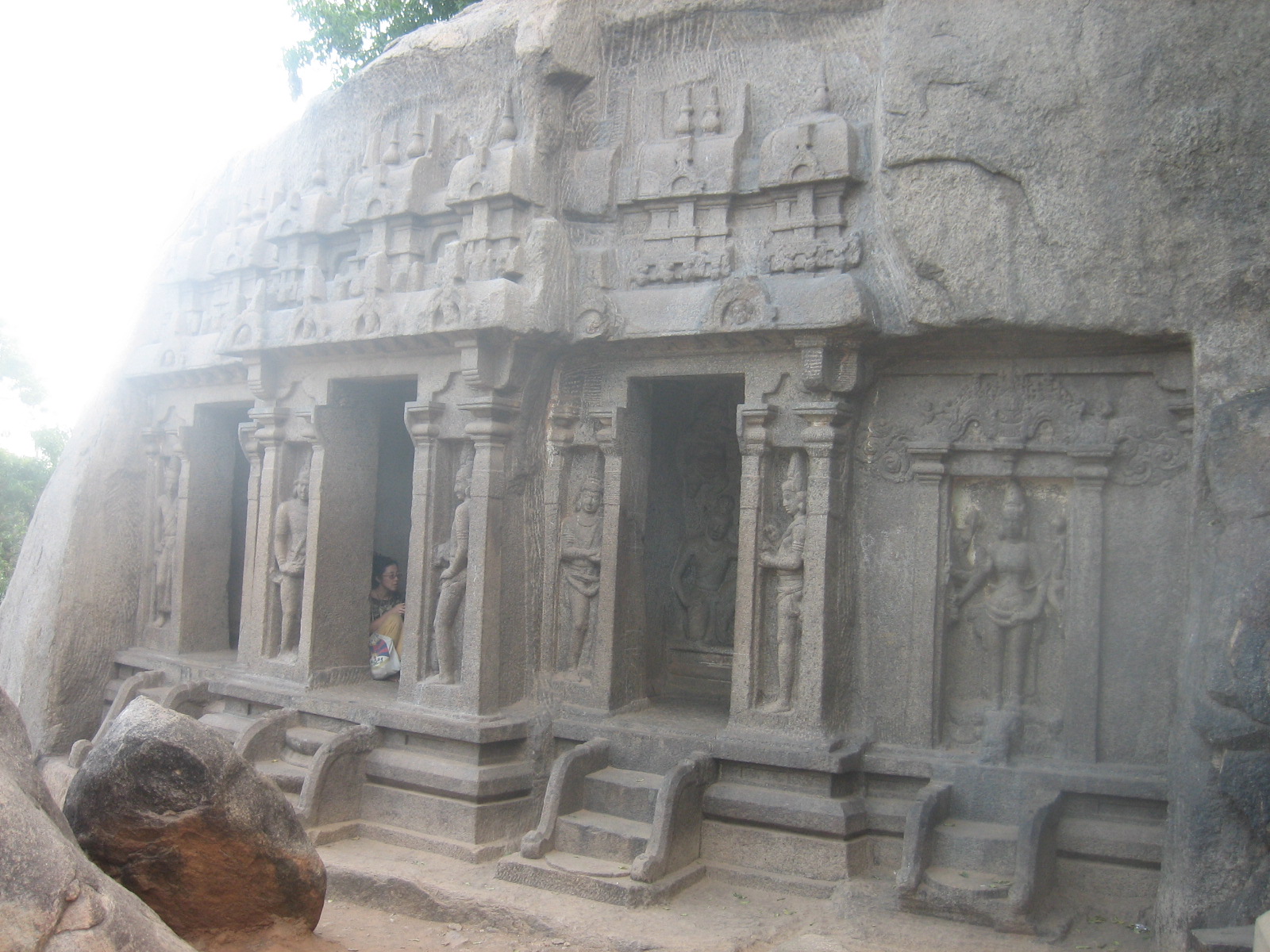Mamallapuram – The Workshop of the Pallavas
Trimurti Cave Temple

This cave temple differs from all other specimens at the site as it does not have a front mandapa or porch. Also it is one among the very few which can put under the category of the most complete excavations. This cave temple consists of three shrines which have been excavated on the western façade of the hill. These shrines have been hewn out sharing a common and contiguous platform, the middle shrine is project forward providing due importance.

As the platform is raised above the ground level, staircases are provided to each shrine. All the shrines are adorned with their own set of dvarapalas, carved in the niches framed between slender pilasters. The upper part of the cave façade is decorated with dormer windows (kudu arches) topped with interconnected oblong shrines.

The dvarapalas of the leftmost shrine are shown with beard, holding flower in their left hand and right hand resting on their waist. The northern dvarapala additionally has a ladle in his right hand. The character of the dvarapalas suggests their association with Brahma. The main image inside the cell has four hands and standing in sambhaga posture. He is holding a rosary in his upper left hand, the object in his upper right hand has been variously identified simply as flower1 or lotus flower2 or a water flask3. His lower right hand is in abhaya-mudra and his lower left hand is resting on his left thigh. There are two ganas on the upper corners, the gana on north holds a pen in his hand in his armpit a book. The other gana carries a bowl of offerings4.
Usually a set of triple shrine suggests dedication to the Hindu trinity of Brahma, Shiva and Vishnu. The case in this temple is also the same, however with one exception that Brahma is replaced with Surbrahmanya. The main image of the leftmost cell does not have three heads as customary representation of Brahma. Also he is shown wearing a channa-vira (cross-chain) across his chest usually seen over kings and warriors. While Vogel5 identifies him with Brahma, Dubreuil6 says that absence of three heads does not favor Brahma and he instead identifies the god with Subramanya. Gopinatha Rao7 identifies him with Brahmasasta explaining that Brahmasasta is a form of Subramanya in which he humiliated Brahma’s pride exposing the ignorance of the latter on the Vedas. Lockwood8 goes with Brahmasasta while Nagaswamy9 goes with Subramanya.

The central shrine has dvarapalas in the Shaiva character as one holds a club and another a lance and a shield. Inside the cell, Shiva is shown standing in sambhaga posture. He has four hands, holding an axe and rosary. His lower right hand is in abhaya-mudra while lower left hand is resting on his left thigh. Two ganas are found in upper corners, and below are two devotees, near Shiva’s feet. In front of the image of Shiva, a linga is inserted however it is a later addition.

The rightmost shrine is dedicated to Vishnu. The dvarapalas are shown standing sidewise in semi-profile. One has raised his hand in suchi-mudra while the other in vismaya-mudra. Inside the cell, Vishnu is shown standing in sambhaga posture. He is shown with four hands, holding chakra (discus) and shankha (conch) in his upper hands. His lower right hand is in abhaya-mudra while lower left hand is resting on his left thigh. There are two ganas on the upper corners while two kneeling devotees are shown on either side of Vishnu, near his feet.
To the right of the Vishnu shrine, on the cave face, is a little shrine of Durga. This shrine is made of a niche between pilasters and topped with a makara-torana. Durga is standing on a severed buffalo head, Mahishasura. She is shown with eight arms holding chakra (discus), shankha (conch), khadga (sword), ketaka (shield), bow. The last attribute is not very clear, Srinivasan identifies it with a bell while Lockwood10 takes it to be an arrow. Her lower right hand is in abhaya-mudra while lower left hand is resting on left thigh.
Inscriptions – There is only one word inscribed near the leftmost shrine and it reads, “Malla“. Dubreuil takes it as the title of Narasimhavarman I.
1 Lockwood, Michael (1993). Mamallapuram – A Guide to the Monuments. Tambaram Research Associates. Chennai. p 156
2 Nagaswamy, R (2008). Mahabalipuram. Oxford University Press. New Delhi. ISBN 9780198071273. p 39
3 Lockwood, Michael (1993). Mamallapuram – A Guide to the Monuments. Tambaram Research Associates. Chennai. p 156
4 Srinivasan, K R (1964). Cave-Temples of the Pallavas. Archaeological Survey of India. New Delhi. p 159
5 Vogel, J Ph. Annual Report of the Archaeological Survey of India for the year 1910-11. p 58
6 Archeologie du Sud De I’ Inde II, p 49
7 Gopinatha Rao, T A. Elements of Hindu Iconography II part II, p 439
8 Lockwood, Michael (1993). Mamallapuram – A Guide to the Monuments. Tambaram Research Associates. Chennai. p 156
9 Nagaswamy, R (2008). Mahabalipuram. Oxford University Press. New Delhi. ISBN 9780198071273. p 39
10 Lockwood, Michael (1993). Mamallapuram – A Guide to the Monuments. Tambaram Research Associates. Chennai. p 162

